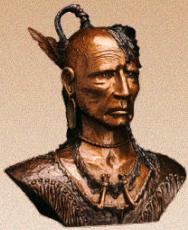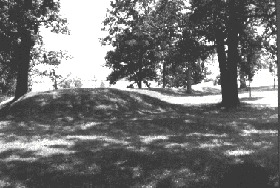

Some time around 1000 B.C. the idea of using fired clay to make pottery containers began to spread into Ontario. This technology probably had little impact on the people of this province, however it is of enormous importance to archaeologists because although pots readily break in use, the broken pieces tend to last extremely well in the ground.
All over the world potters have found the semi-hard clay surface of freshly shaped pots (ie. before firing) to be an irresistible canvas for decoration and art. Since fashions and design preferences gradually change through time and from one people to another, the patterns of pottery decoration, and even the shape of the pots themselves provide valuable and accurate clues to the age and culture of the people who made them.
The Early Woodland people of Ontario were the first to use pottery in this province. In may other respects, people of the EARLY WOODLAND PERIOD (c. 900 B.C. - 300 B.C.) continued to live in much the same way as their predecessors of the Late Archaic. Like the Late Archaic people, they buried their dead with great ceremony, often including attractive and exotic artifacts in the graves. The Early Woodland people of Ontario appear to have been in contact with, or at least heavily influenced by their neighbours to the south - particularly the Adena people of the Ohio Valley.
So far no true Early Woodland tradition has been discovered in northern Ontario. The introduction of pottery into that part of the province does not seem to have occurred until much later.
The most distinctive way in which the Middle Woodland period (c. 300 B.C. - A.D. 900) differs from the Early Woodland is in the way the people of Ontario had broadened the methods they used to decorate their pots. Changes in the shapes and types of tools used, the raw materials chosen and the ways in which these were acquired and traded are also apparent. However, these subtle technological changes mask more fundamental differences. Evidence from numerous archaeological sites indicate that by the MIDDLE WOODLAND PERIOD the people of Ontario began to identify with specific regions of the province. The artifacts from Middle Woodland period sites in southwestern Ontario differ quite noticeably, for instance, from those of the people in eastern Ontario. For the first time it is possible to distinguish regional cultural traditions - sets of characteristics which are unique to a part of the province. Archaeologists have named these cultural traditions LAUREL (throughout northern Ontario), POINT PENINSULA (in eastern and south-central Ontario), SAUGEEN (in much of southwestern Ontario) and COUTURE (in extreme southwestern Ontario).
Archaeologists have developed a picture of the seasonal patterns these people used in order to exploit the wide variety of resources in their home territories. During the spring, summer and fall groups of people congregated at lakeshore sites to fish, collect shellfish (in the south) and hunt in the surrounding forests. As the seasons progressed the emphasis probably shifted away from fishing and more towards hunting, as the need to store up large quantities of food for the winter became more pressing. By late fall, or early winter, the community would split into small family hunting groups and each would return to a 'family' hunting area inland to await the return of spring.
Some Middle Woodland people may have been influenced by a vigorous culture to the south - the Hopewell. These people buried some of their dead in specially prepared burial mounds, and accompanied the bodies with many and varied objects.
Some Ontario people, especially those in the Rice Lake and Rainy River areas adopted this practice, although they tailored it to suit their local needs. Some archaeologists have argued that since not all people were buried in the same way, these rich burials indicate that a heirachy or class structure was beginning to develop as has been noted among the Hopewell. Such class distinctions do not seem to have lasted long, however, and were not part of Late Woodland life.

POINT PENINSULA
Point Peninsula is a Middle Woodland complex which occurred in central and eastern parts of southern Ontario. It also extended into parts of western Quebec and northern new York State. Point Penisula sites have been found as far west as the Niagara Peninsula, although there is some dispute whether the materials from this far west should be called Point Peninsula or Saugeen. Point Peninsula sites date to the period between between 300 B.C. and A.D. 700, although most date to after A.D. 0.
THE LAUREL CULTURE
The people of the Laurel Culture (or tradition) were the first known people in northern Ontario to use pottery. These people made coil made, finely decorated, conoidal pots (click on the pottery button for more details). The use of pottery seems to have occurred rapidly throughout a broad band of country extending from northern Saskatchewan to the Quebec border. Other characteristics of Laurel sites include the construction of burial mounds (restricted to areas to the west of Lake Superior), the use of toggle headed bone harpoons, and the manufacture and use of small, cold hammered copper implements and paintstone nodules.
THE COUTURE COMPLEX
Investigations in southwestern Ontario have resulted in the definition of the 'Couture Complex'. Couture Complex sites are found along the rivers and streams which drain into Lake St. Clair and the northwestern shore of Lake Erie. Most Couture sites are found in these areas, although some Couture Complex sites have been recorded in the London and Thedford areas.
These Middle Woodland people made thick, corded, coil made pots with constricted necks, pointed or flattened rims and (probable) bi- conical vessel forms. These vessels are distinct from those from Middle Woodland Saugeen sites to the east, and have more in common with early Middle Woodland pottery types from Michigan and Ohio, such as Leimbach cordmarked and Shiawassee cordmarked.
SAUGEEN COMPLEX
Saugeen is a Middle Woodland complex which has been recognized in central southern Ontario. Saugeen sites have been found along the south shores of Lake Huron, west as far as the Thames River, and east to the Grand River. Most Saugeen sites date to the period between between 200 B.C. and A.D. 700.
